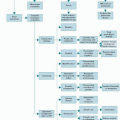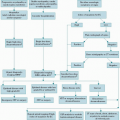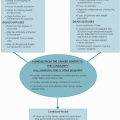PRURITUS SENSATIONS
In simplest terms,
pruritus is the sensation that provokes scratching. Chronic itch can be mild or intractable—a persistent itch state in which the cause cannot be removed or treated and the cure has not been found in the domains of accepted medical practice (
14). Like the sensation of pain, objective analysis cannot easily confirm the presence or severity of pruritus. Nevertheless, patients are generally thought to be reliable in their assessment of pruritus severity. Scratch marks (
excoriations), skin thickening (
lichenification), and visible cutaneous disease often support patients’ subjective complaints.
Patients may complain of burning, stinging, tingling, tickling, or a crawling sensation in addition to, or in lieu of, classic itch. These symptoms are closely related to pruritus, have similar pathogenic mechanisms, and are treated identically. Bernhard (
15) summarized this notion by stating, “one man’s itch is another man’s tickle … and one man’s stinging itch is another man’s pain.” For most people, itch is readily distinguished from pain, and many patients with severe pruritus would be happy to have pain instead (
16). Perhaps more important still, there is new evidence to suggest that itch may not only degrade quality of life but may also actually impact survival. Pruritus in dialysis patients is associated with a 17% higher mortality, though this may be associated with poor sleep quality (
16). Gobbi et al. (
17) reported that severe pruritus in Hodgkin’s disease predicts a poor prognosis.
Pruritus is a distinct, complex sensation that may be considered a primary sensory modality (
10). A recently published position paper from the International Forum for the Study of Itch reclassified itch into several overlapping categories so that diagnosis and treatment of this ubiquitous but elusive condition might be optimized (
18). They proposed three groups of conditions: pruritus on inflamed skin (Group I), pruritus on non-inflamed skin (Group II), and pruritus presenting with severe secondary skin changes (Group III). Underlying disease, which may be present in one or more groups and may drive the itch sensation, is then defined as a dermatologic disease, a systemic disease, a neurologic disease or, least commonly, a psychiatric disease.
Though there are new data emerging on the origin and propagators of itch in each group or subtype, it is known that at least a portion of the cutaneous itch response is carried by unique sensory histamine-sensitive but mechanoinsensitive C fibers (
19). These unmyelinated fibers carry sensations to the spinothalamic tract, where they are relayed to the thalamus and subthalamus. Experimental injection of histamine into the skin induces itch or pain. This histamineinduced pruritus may be suppressed by systemic antihistamine administration (
20). In spite of the nearly identical histologic characteristics of itch fibers and pain receptors, the two entities may be distinguished electrophysiologically. Nevertheless, the means by which they exert their phenotypic responses may show considerable commonality. For instance, just as sensitization of nerve endings is a known mechanism for chronic pain, patients with chronic itch have demonstrated an increase in skin innervation and may also show central sensitization of itch-signaling spinal neurons (
21,
22).
Because many patients with pruritus show no signs of histamine release (e.g., cutaneous wheal and flare) and because this pathway cannot explain itch caused by mechanical properties, it is now a well-accepted tenet that other elements (e.g., cytokines and neuropeptides) cause a substantial portion of pruritus. The failure of many pruritic conditions to improve with antihistamines supports this theory and furthermore suggests that histamine may in fact be only a minor pruritus mediator (
23,
24). In the last several years, there have been landmark developments in this field. It is understood
that pruritus may be caused by opiates, serotonin, other neuropeptides, prostaglandins, kinins, proteases, and physical stimuli (
10). Tumor necrosis factor-α (TNF-α), though it may not have a direct pruritogenic effect, is elevated in many diseases that are characteristically associated with itch (
2). Similarly, a vanilloid receptor, TRPV1, showed increased expression in patients with prurigo nodularis (
25). Proteaseactivated receptor 2 (PAR-2), a specific receptor on primary afferent nerves that is activated by tryptase, was recently found to be elevated in patients with atopic dermatitis (
26). Each of these agents may induce pruritus primarily or act through secondary mediators.
Since the 1950s, a plant containing the protease mucunanin was known to cause itch without the characteristically associated flare, an erythematous reaction that is transmitted by mechano-insensitive C fibers (
27). Recent evidence revealed that mucunanin induces itch by activating a group of “polymodal” C fibers that respond to mechanical stimuli instead of histamine, a distinctly different population of C fibers than those activated by histamine but with the same end result of itch (
28,
29). The role of this alternate pathway is yet to be fully understood, though it is thought that “polymodal” C fibers are the most frequent type of afferent C fibers in human skin nerves (
30). These advances in our understanding of the propagators of itch proffer hope for potential treatment to those afflicted.
The sensation of pruritus may also arise within the central nervous system (CNS). Systemic opioids induce pruritus, and the opioid antagonists, including naloxone hydrochloride, naltrexone hydrochloride, and nalmefene (which has been withdrawn from the market in the United States), decrease the pruritus of cholestatic and other liver diseases (
31,
32,
33,
34). Exogenous opioids administered in small quantities to spinal levels in spinal anesthesia relieve pain and can stimulate itching (
35). Plasma from patients with cholestatic itching leads to scratching behavior in murine models; this scratching is abolished by administering the opioid receptor antagonist naloxone hydrochloride (
36). Itch may also occur paroxysmally after CNS insult or with phantom limb itch as seen after mastectomy (
37,
38,
39).
DERMATOLOGIC DISEASES AND PRURITUS
Many skin diseases may contribute to the sensation of pruritus. Dry skin, or
xerosis, is commonly seen in patients with cancer who have generalized wasting or have undergone chemotherapy or radiation therapy. Xerosis makes the skin more susceptible to irritation from environmental assault (
40).
Many other diseases may present with pruritus, including scabies, atopic dermatitis, dermatitis herpetiformis, bullous pemphigoid, miliaria, pediculosis, and urticaria (
41). These cutaneous diseases are often readily diagnosed by careful clinical examination. Signs of dermatologic diseases may be remarkably subtle or nonspecific in any given patient, particularly in the immunocompromised host. There is no substitute for an excellent physical examination of the skin surface (
42,
43,
44,
45,
46,
47,
48).
PRURITUS AND MALIGNANCY
Pruritus may be associated with virtually any malignancy (
Table 23.1) (
5,
17,
49,
50,
51,
52,
53,
54,
55,
56,
57,
58,
59,
60,
61,
62,
63). Some neoplasms, particularly hematologic malignancies, are more frequently associated with pruritus, among them being polycythemia and Hodgkin’s disease. Cutaneous T-cell lymphoma, peripheral T-cell lymphoma, and other cutaneous lymphomas are notoriously pruritic. Though it has not been fully investigated, endogenous opioids may play a role in lymphoma-induced pruritus as evidenced by the efficacy of butorphanol, a κ-agonist and µ-antagonist, in treating non-Hodgkin’s lymphoma pruritus (
64). Furthermore, cytokines such as interleukin (IL)-6 and IL-8, which are suspect in End Stage Renal Disease (ESRD) associated pruritus, have been found to be closely related to the pathophysiology of lymphoma, and therefore may play a role in lymphoma-induced itch as well (
14,
65,
66). Neurokinin-1, a neuropeptide, is suspected to contribute to itch in patients with malignancy as well. The dominant ligand for neurokinin-1 is substance P, and an increase in the number of neurokinin-1 receptors has been found on keratinocytes in patients with chronic pruritus (
67,
68,
69).
Pruritus may be a presenting symptom in both solid and hematologic cancers (
70,
71). Pruritus may also be a sign of malignant physical obstruction of the biliary system from either a primary or metastatic tumor (
61). In solid tumors, pruritus is thought to be due, at least in part, to a local immune phenomenon and may be generalized or localized, such as with scrotal itch in the setting of prostate cancer (
72).








